【ProAV Lab】introAVoIP#03 - Introduction to Compression Algorithm in AVoIP
By Kieron Seth & Seaco Wei, Lumens
July 01, 2022 25457

▶ Compression is an enabling technology for AVoIP
In the AVoIP industry, compression is an enabling technology to squeeze audio-video data into commercial Ethernet frames that travel in high speed. Thanks to the evolution of network technology and the advancement of compression algorithm, it is now possible to make AV over IP come true.
The most popular AVoIP protocols are NDI, SDVOE, Dante AV, and IPMX. They adapt different compression algorithms which need trade-off between latency, image quality, and bit-rate. The compression technology has been constantly evolving to achieve better efficiency but the basic rule still applies lack of bandwidth means a higher compression ratio and a more complicated computing environment generally causes more latency. Among the above protocols, only SDVOE is targeted at 10G Ethernet. The rest of them all select 1G Ethernet that is the most cost-effective choice. The selection of the compression technology would be different, based on your requirement of 10G or 1G Ethernet environment. Please see the below time line and Table 1 for more information.
▼Compression Standard Timeline

▼Table 1: Compression Ratio for different resolutions and bit rate
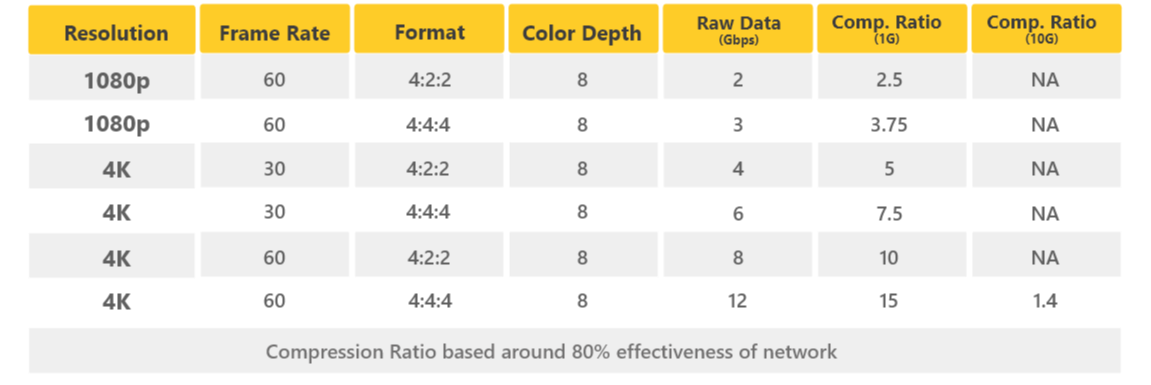
NDI ( Network Device Interface)
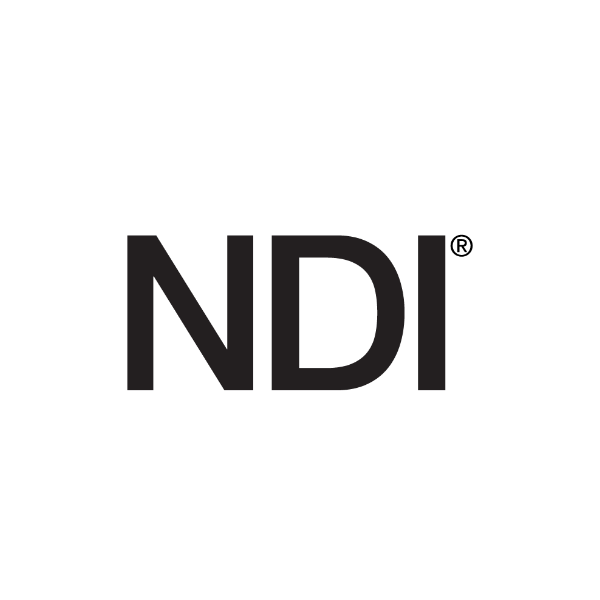
NDI was publicly announced by NewTek on 8 September 2015. It is an IP protocol that can carry many kinds of compression data formats such as SHQ (MPEG-2 like but not exactly the same), H.264, and HEVC bit streams. SHQ is only for Intra picture coding and H.264/HEVC adopts Intra and Inter picture coding.
NDI technology is designed for video signals transmission through IP network and is based on 1G Ethernet. A video signal, by definition, means a series of video images generated from a camera by capturing natural scenes, which is different from computer graphics and spread sheets. Its latency is around 100ms due to frame based compression. NDI has different protocol variations such as HX2, HX3, and HB. They are based on different compression schemes and have different bit rate requirements. Please see Figure 2 and Table 2 for more information.
▼Figure 2: NDI Protocol Variations

▼ Table 2: NDI Protocol Target Bit Rate

SDVoE ( Software Defined Video over Ethernet )
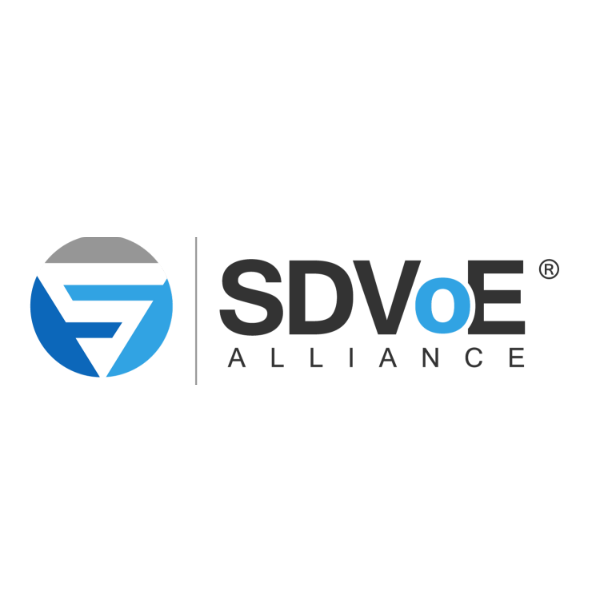
SDVoE is designed for visual lossless long cable transmission. It takes the image quality and latency as the first priority and bets on 10G Ethernet to become the future mainstream network infrastructure.
4K@30 content travels uncompressed and 4K@60 content only with requires 1.5 lite proprietary compression, with a maximum latency of 100 micro seconds.
Its target is to compete with HDbaseT HDMI signal Long cable technology, at the same time satisfies the needs of computer spreadsheets and graphic contents. HDbaseT is not an IP technology but a signal modulation mechanism for video signals to travel within CAT6 Cable.
Dante AV

Dante AV is a revolutionary new AV solution for standard 1 Gbps network, which allows manufacturers to add networked video to the industry-leading Dante audio-over-IP platform. It provides the ease-of-use, seamless multi-vendor interoperability, and integrated control experience that customers have come to expect from Dante.
Dante AV, with the same target application as that of NDI for video, uses JPEG 2000 compression technology instead. JPEG2000 is an ISO standard wavelet transform having higher compression ratio than JPEG. Recently, Audinate has further developed Dante AV Control to adopt other compression technologies such as H.264, and HEVC for integration with the Dante AV protocol.
IPMX (Internet Protocol Media Experience)
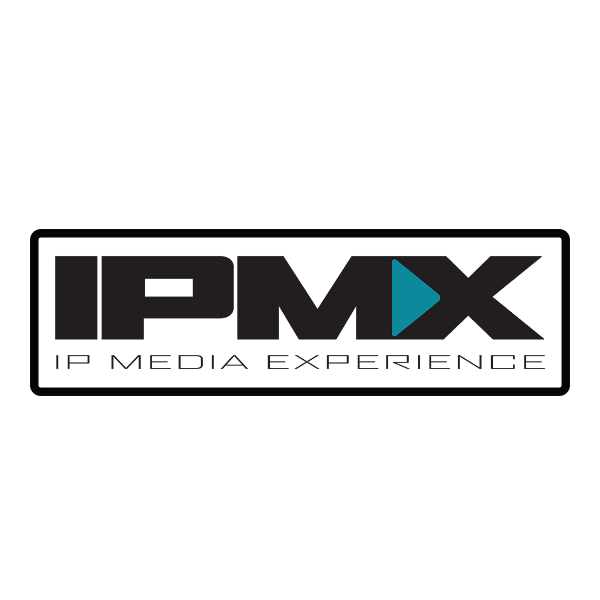
DIPMX was created by AIMS (the Alliance for IP Media Solutions), a non-profit trade alliance that fosters the adoption of one set of common, ubiquitous, standards-based protocols for interoperability over IP in the media and entertainment (M&E) and professional audio/video industries.
IPMX is a proposed set of open standards and specifications to enable the carriage of compressed and uncompressed video, audio, and data over IP networks for the pro AV market. IPMX proposes ISO standard JPEG-XS as the compression technology for video processing based on 1G Ethernet Network.
▶ Summary
A summarized table has been created as shown below for comparisons between the four AVoIP protocols from different angles.
IPMX is an open standard that will have the BEST interoperability as it originates from the broadcast industry and after making some amendments, fits in perfectly with the Pro-AV industry. We can certainly count on this future-proof technology.
NDI is currently the most popular standard with a wide acceptance due to its 6-year earlier market development and the sophisticated SDK developing environment. It adopts the H.264 and HEVC codec to use existing SOC solutions for the best cost performance.
Dante AV is a new comer and has tried to leverage its audio popularity to address the pro-AV AVoIP market, and as such it will be a strong competitor to NDI.
SDVoE positions itself in the high-end market with high quality, low latency, and high bandwidth features to dominate the control room application.
▼ Table 3: AVoIP Protocols Comparison Chart
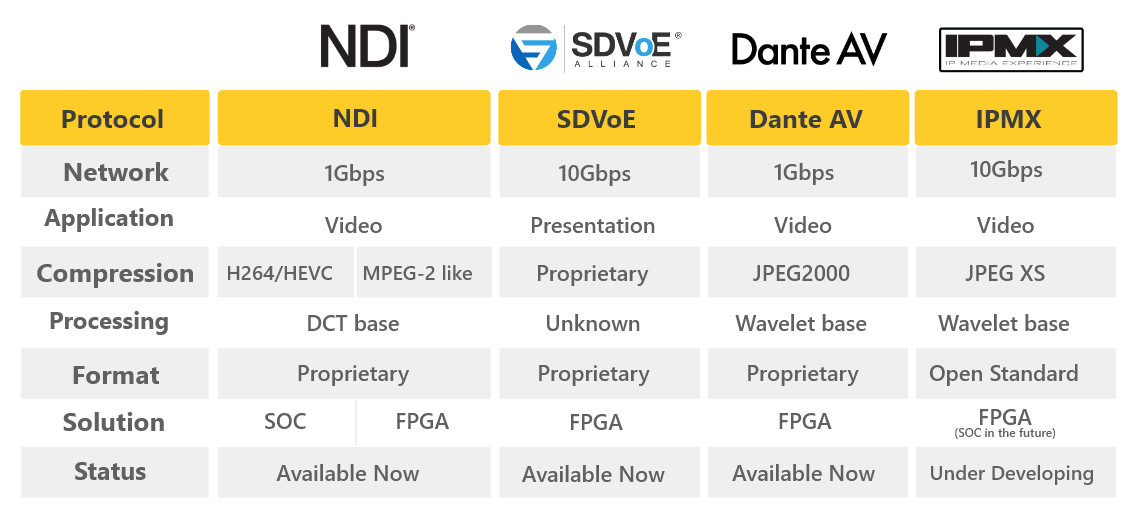
Click here Back to Top ↑